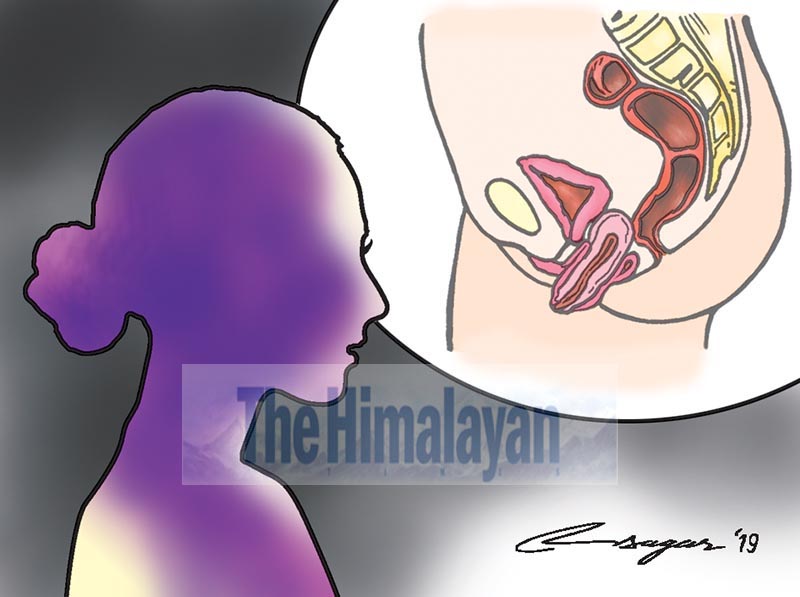Uterine prolapse: Nothing to be ashamed of
Uterine prolapse is preventable, and not all cases require surgical removal of the uterus. Having better knowledge about uterine prolapse and minimising the risk factors are already a preventive intervention
As a medical student, we have clinical classes in different departments of the hospital. We come across numerous cases in a particular department, and we learn about them on a daily basis. Currently, my group is having classes in gynaecology. In the gynaecology ward, the most common case that we encounter is pelvic organ prolapse, meaning descending of the pelvic organs, namely the uterus, urinary bladder and rectum via the birth canal (vagina). Sometimes the tissues that line up the vagina might as well fall down.
I didn’t give much priority to this case earlier and studied it like I’d study any other case until the increasing number of such cases caught my attention. During four weeks of gynaecology posting, there wasn’t a single day when the ward did not have less than three cases of any form of organ prolapse - uterine prolapse being at the top of the list. Uterine prolapse means herniation (coming out) of the uterus from the abdominal area through the birth canal.
Of all the cases, the case that captivated me the most was that of a 70-year-old woman who had had a fully prolapsed uterus since the last 26 years, for which she got operated just recently. She comes from the hills and is a mother of eight and weighs 32 kilograms. Seemingly malnourished, this feeble-looking woman has lived more than a third of her entire life with her uterus bulging out of her vagina. To know what it feels like, imagine having a tennis ball between your thighs in your private area and living with that all the time. Discomfort apart, quite a few complications arise with it, affecting the quality of life.
She said she never told about it to anyone because she was ashamed of it and had never visited any health centre. She visited the regional health post only when the complications increased.
She faced a major complication of pelvic organ prolapse that is urinary incontinence, meaning she could not control her urine and urinated spontaneously even when minimal pressure was applied on her abdomen, especially while coughing or laughing. It happens because when the uterus comes down from its normal position, it compresses the urinary bladder.
There are a lot of things inside a woman’s body that keeps the uterus in place. Firstly, the normal position of the uterus itself. It is positioned in such a way that it doesn’t come out through the birth canal. The other important factors are the ligaments, which are rope like in structure, and the muscles, called pelvic floor muscles, that support it. So we can say the uterus is a pouch-like muscular organ, which is tied to the human body and is suspended with rope like-structures called ligaments. If the pelvic floor muscles and the ligaments become weak or stretched out, they cannot support the uterus, and the uterus prolapses or hangs down. There are a lot of factors that cause the weakening of these muscles and the ligaments.
The risk factors for uterine prolapse would include all those things that would put pressure on the pelvic floor muscles and the ligaments. Heavy workload, multiple pregnancies, smoking, chronic cough and chronic constipation are just a few to list. The woman had outnumbered almost all the risk factors. She had given birth to eight children herself without the help of even a midwife. Some were delivered while she was working on the farm or while collecting firewood.
She also turned out to be a chronic smoker and had also suffered from tuberculosis (TB) once, which gave her the chronic cough. Coming from a village in the hills, the workload there is undoubtedly heavy. For treatment, she had undergone Hysterectomy (surgical removal of the uterus).
Later that day, after I came home I read some online research articles on the prevalence of uterine prolapse in Nepal and was completely stunned. According to the sources, the prevalence of uterine prolapse among women in Nepal varies somewhere between 10% and 37% and is one of the major reproductive health issues among Nepali women.
An estimated number of 600,000 women in Nepal suffer from uterine prolapse, about a third requiring immediate surgical treatment.
However, those numbers outline only the registered cases, which is only a fraction of the population that suffers from it.
A lot of other cases are not registered due to a lot of causes, fear and shame being the major ones. I also came to know that not only multiple pregnancies and deliveries are a risk factor, but also lack of rest during pregnancy and after delivery is a major contributing factor. Not only that, malnutrition and lack of proper diet were also found to be associated.
Uterine prolapse is preventable, and not all cases require surgical removal of the uterus. Having better knowledge about uterine prolapse and minimising the risk factors are already a preventive intervention. Other than that, performing pelvic floor muscle exercises on a regular basis can also be fruitful.
The exercise is called Kegel exercise and is found to strengthen the pelvic floor muscles and thus decrease the risk of having a prolapse. In my opinion, women of our country should be more aware of the condition, and they should also be well aware that it is not something to be ashamed about. And visiting a doctor regarding your health issue shouldn’t be a matter of hesitation.






